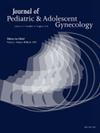58. 生殖健康知识能预防青少年怀孕吗?
IF 1.8
4区 医学
Q3 OBSTETRICS & GYNECOLOGY
引用次数: 0
摘要
虽然青少年怀孕率正在下降,但这仍然是一个紧迫的问题。关于预防青少年怀孕的数据有限,但避孕和与家庭和社区的接触已被确定为具有保护作用。更普遍的干预可能产生更公平的结果。本研究旨在确定女性泌尿生殖系统(GU)结构的知识是否与青少年不孕有关,通过识别数字图像上的解剖结构进行评估。未生育的青少年比已生育的青少年能正确识别更多的女性GU结构。方法研究对象为美国肯塔基大学青少年医学诊所(AMC)或青年家长计划诊所(YPP)的青少年(12-21岁)。参与者在iPad上完成关于人口统计、教育背景和识别GU结构的调查后,通过邮件收到了20美元的支票。调查以英语和西班牙语提供。这是一项有目的抽样的横断面研究。样本量为103,其中55例来自AMC, 48例来自YPP。采用Fisher精确检验、χ2检验和Shapiro-Wilk正态性检验比较两组间的答案。p≤0.05,均为双侧检验。各自的诊所出勤率是预测变量。主要结果是正确识别的GU结构的数量和百分比。肯塔基大学机构审查委员会批准了这项研究(#81195)。结果AMC参与者的得分显著高于YPP参与者,他们的中位总体正确反应更高(17比13)。AMC组正确率中位数为89.5%,YPP组正确率中位数为68.4%(表2)。因此,假设成立。生殖教育程度组间差异显著。在AMC组中,41.1%的人接受过6-9年级的教育,39%的人接受过高中以上的教育,20.5%的人没有接受过教育,而YPP组的这一比例分别为58.5%,29%和12%(表1)。结论这些结果表明生殖健康知识可能是预防青少年怀孕的保护变量。尽管大多数未生育的青少年在高中毕业后接受过教育,或者根本没有接受过教育。有趣的是,学生们被教授生殖解剖学,但这些概念并没有在以后的年级(10-12年级)被重新学习,那时青少年可能更有可能从事性活动。尽管在学校实施了健康教育,但分娩和分娩时间可能是无效的。这些结论受到研究的横断面设计的限制,但在种族和民族多样化的样本人群中得到了加强。本文章由计算机程序翻译,如有差异,请以英文原文为准。
58. Is Reproductive Health Knowledge Protective Against Adolescent Pregnancy?
Background
Though teen pregnancy rates are declining, it remains a pressing issue. Data is limited on prevention of teen pregnancy but contraception and engagement with family and community have been identified as protective. A more universal intervention may have more equitable results. This study aims to identify if knowledge of female genitourinary (GU) structures is associated with nulliparity in adolescents, assessed by identification of anatomical structures on a digital image. Nulliparous adolescents will identify more female GU structures correctly than parous adolescents.
Methods
Subjects were adolescents (12-21 years old) and patients of University of Kentucky's Adolescent Medicine Clinic (AMC) or Young Parent Program Clinic (YPP). Participant's received a $20 check through the mail after completing a survey on an iPad with questions about demographics, educational background, and identification of GU structures. The survey was offered in English and Spanish. This was a cross-sectional study with purposive sampling. Sample size was 103, 55 from the AMC and 48 from YPP. Fisher's exact, χ2, and Shapiro-Wilk normality tests were used to compare answers between the two groups. Statistical significance was set at p≤0.05, all tests were two-sided. Respective clinic attendance was the predictive variable. The primary outcome was the number and percent of GU structures identified correctly. University of Kentucky Institutional Review Board approved this study (#81195).
Results
The participants in AMC scored significantly higher than YPP participants having a higher median overall correct responses (17 vs 13). The median percent correct was 89.5% in the AMC group and 68.4% in the YPP group (Table 2). Therefore, the hypothesis was accepted as true. Grade of reproductive education differed significantly between groups. In the AMC group 41.1% reported education in grades 6-9, 39% beyond high school, and 20.5% received no education compared to 58.5%, 29% and 12% in the YPP group, respectively (Table 1).
Conclusions
These results suggest reproductive health knowledge may serve as a protective variable against teen pregnancy. Though a majority of nulliparous teens reported receiving education after high school or no education at all. Interestingly, students are taught reproductive anatomy, but these concepts are not revisited at later grade levels (10-12) when adolescents may be more likely to engage in sexual activity. Despite health education being implemented in schools, the delivery and delivery timing may be ineffective. These conclusions are limited by the cross-sectional design of the study but strengthened by a racially and ethnically diverse sample population.
求助全文
通过发布文献求助,成功后即可免费获取论文全文。
去求助
来源期刊
CiteScore
3.90
自引率
11.10%
发文量
251
审稿时长
57 days
期刊介绍:
Journal of Pediatric and Adolescent Gynecology includes all aspects of clinical and basic science research in pediatric and adolescent gynecology. The Journal draws on expertise from a variety of disciplines including pediatrics, obstetrics and gynecology, reproduction and gynecology, reproductive and pediatric endocrinology, genetics, and molecular biology.
The Journal of Pediatric and Adolescent Gynecology features original studies, review articles, book and literature reviews, letters to the editor, and communications in brief. It is an essential resource for the libraries of OB/GYN specialists, as well as pediatricians and primary care physicians.

 求助内容:
求助内容: 应助结果提醒方式:
应助结果提醒方式:


